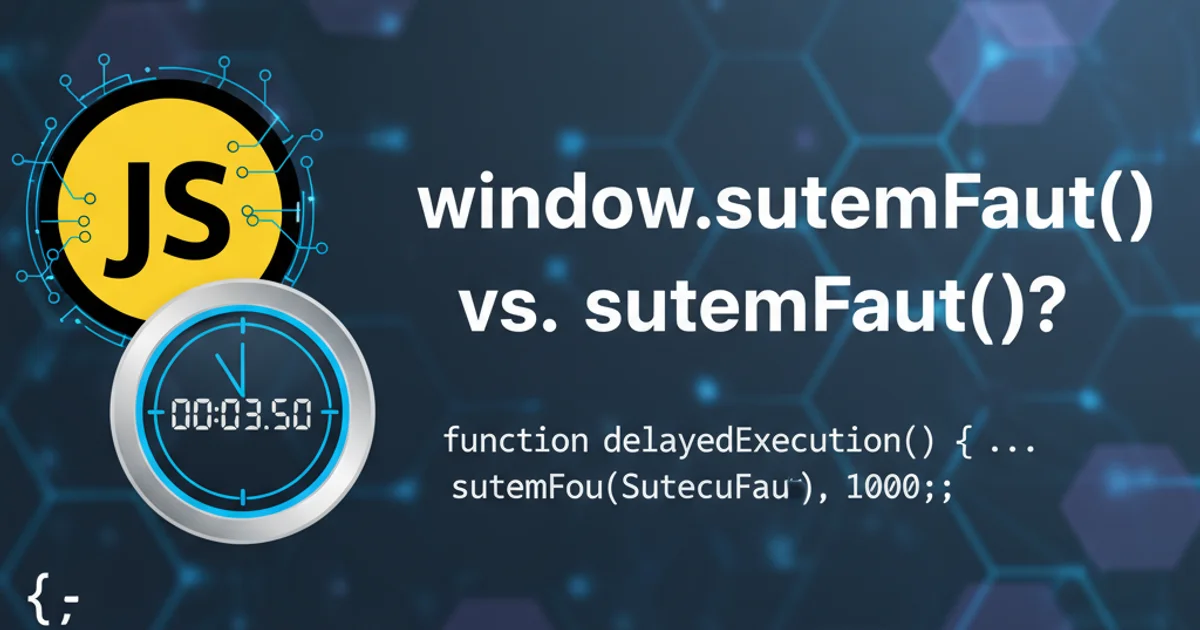What the difference between window.setTimeout() and setTimeout()?
Categories:
window.setTimeout() vs. setTimeout(): Understanding JavaScript's Timer Functions

Explore the subtle but important differences between window.setTimeout() and setTimeout() in JavaScript, and learn when to use each for robust timer management.
In JavaScript, you often encounter two ways to call the setTimeout function: window.setTimeout() and setTimeout(). While they appear similar and often behave identically in a browser environment, understanding their underlying mechanisms and potential differences is crucial for writing robust and maintainable code. This article will demystify these two forms, explain their relationship, and highlight scenarios where the distinction matters.
The Global Object and setTimeout()
In web browsers, the global object is window. This object serves as the top-level container for all global variables, functions, and objects provided by the browser environment. When you declare a global variable or function, it becomes a property of the window object. The setTimeout() function is one such global function, meaning it's a property of the window object.
console.log(window.setTimeout === setTimeout); // true
console.log(typeof window.setTimeout); // 'function'
console.log(typeof setTimeout); // 'function'
Demonstrating that setTimeout is a property of the window object
Because setTimeout() is a property of the global window object, you can access it directly without explicitly referencing window. This is a common shorthand in JavaScript, similar to how you might access other global functions like alert() or console.log().
Context and Scope: When the Difference Matters
While window.setTimeout() and setTimeout() typically refer to the same function in a browser, there are specific contexts where the explicit window prefix can be important or where setTimeout might refer to something else entirely. These scenarios primarily involve non-browser environments or situations where setTimeout might be shadowed.
flowchart TD
A[Call setTimeout()] --> B{Is it a browser environment?}
B -- Yes --> C[Refers to window.setTimeout()]
B -- No --> D{Is setTimeout() defined locally?}
D -- Yes --> E[Refers to local setTimeout()]
D -- No --> F[Error or undefined behavior]Decision flow for resolving setTimeout() calls
setTimeout() without the window prefix is perfectly acceptable and common practice. The explicit window.setTimeout() can sometimes be used for clarity or to guard against potential name collisions in complex codebases or specific module patterns.Non-Browser Environments and Shadowing
In environments like Node.js, the global object is not window but global. Node.js provides its own setTimeout function, which is globally available but not a property of window. Therefore, window.setTimeout() would be undefined in Node.js, while setTimeout() would correctly refer to Node.js's timer function.
Another scenario is when a local variable or function within a specific scope is named setTimeout. In such cases, the local setTimeout would 'shadow' the global one, meaning setTimeout() would refer to the local definition, while window.setTimeout() would still refer to the global browser function (if in a browser environment).
// In a browser environment:
function myFunction() {
const setTimeout = () => console.log('Local setTimeout!');
setTimeout(); // Calls the local function
window.setTimeout(() => console.log('Global setTimeout!'), 0); // Calls the browser's global function
}
myFunction();
Example of local variable shadowing the global setTimeout